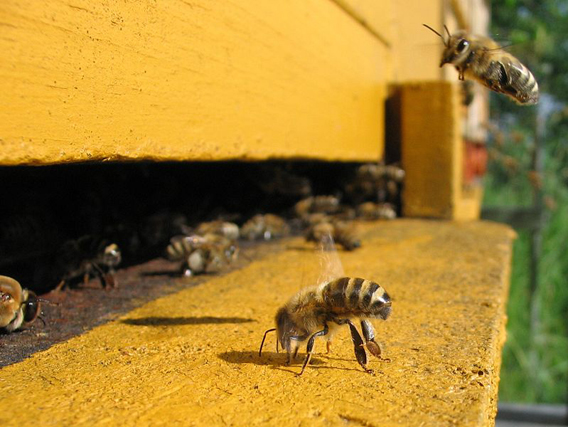
Honeybees in an apiary in Germany. Photo by: Björn Appel.
May Berenbaum knows a thing or two about insects: in recognition of her lifelong work on the interactions between insects and plants, she has had a character on The X-Files named after her, received the Public Understanding of Science and Technology Award for her work in making science accessible to the public, and this year has been awarded the prestigious Tyler Environmental Prize.
“Winning the Tyler Prize is an incredible honor—most of my scientific heroes have been Tyler Prize winners and I’m exceedingly grateful to be considered worthy of being included among their ranks,” Berenbaum told mongabay.com in an interview. “The Prize is also tremendously enabling—because the money is unrestricted I can use it to carry out projects that have been difficult to fund.” The Tyler Environmental Prize includes a $200,000 reward with no strings attached.
Berenbaum of the University of Illinois at Urbana-Champaign has alos become a well-respected figure in conducting and communicating the complex research on why bee populations are vanishing across the US and, more recently, in other parts of the world.
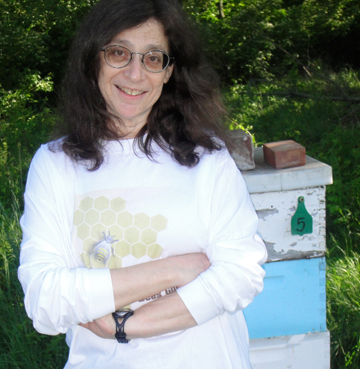 May Berenbaum at an apiary. Photo courtesy of Berenbaum. |
“There is a lot of evidence accumulating that honey bees are severely challenged by multiple pathogens—viruses and fungi in particular—and they may not be able to cope with this challenge. Contributing factors may be stresses that compromise the immune system—poor nutrition and possibly pesticides,” Berenbaum explains.
Her research on the million-years-war (without a truce) between insects and plants has broken new ground and provided new understanding on the challenges agriculture faces, and will forever face, when it comes to insects.
“Insects and weeds are highly adaptable and evolve rapidly—no interaction is static and we can expect pests to evolve coping mechanisms in response to almost anything we attempt to use to control them,” she says.
Outside of research, one of Berenbaum’s missions is to bring the importance of science, and insects especially, to the public. Apart from being considered pests, most people overlook the vital services insects provide.
“People tend to equate small size with unimportance but that’s simply not a biologically realistic point of view,” she says. “The importance of insects to maintaining most ecosystems is wildly disproportionate to their size—insects are among the world’s most irreplaceable pollinators, nutrient recyclers, and waste haulers.”
In an April 2011 interview May Berenbaum discussed going from loathing to loving bugs, current research on the collapse of bee populations, the never-ending war between plants and insects, and what the Tyler Environmental Prize means to her.

INTERVIEW WITH MAY BERENBAUM
Mongabay: Congratulations on winning the Tyler Prize for Environmental Achievement! Will you tell us what this prize means to you and your work?
Mary Berenbaum: First of all, winning the Tyler Prize is an incredible honor—most of my scientific heroes have been Tyler Prize winners and I’m exceedingly grateful to be considered worthy of being included among their ranks. The Prize is also tremendously enabling—because the money is unrestricted I can use it to carry out projects that have been difficult to fund. There are few federal or private funding sources for citizen science, for example, and we have a project, involving bee population monitoring, that has been running largely on altruism for several years that could benefit from an infusion of funds.
Mongabay: How did you get interested in insects?
Mary Berenbaum: Actually, as a child I was afraid of insects—I liked biology but around the age of seven I became very entomophobic. I entered Yale University as a biology major but I placed out of introductory biology because of AP credit and could take an upper-level course spring semester, but the only course that fit into my schedule was “Terrestrial Arthropods,” which I knew would be about insects. I signed up for the course, figuring I’d learn at least which insects to be afraid of, but by the end of the semester I was so fascinated that I decided that I wanted to be an entomologist.
BEE COLLAPSE
Mongabay: You’ve done considerable work on the worrying collapse of bees in the US and elsewhere. This is an often confusing issue to follow given all the different theories and research. Where does the science currently stand regarding the factors behind this?
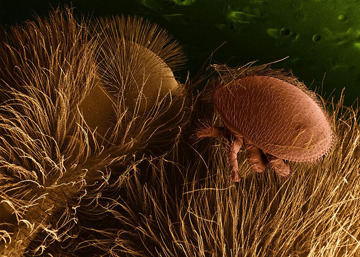 A parasitic mite on a bee that can lead to fatality for the bee host. Photo by: US Department of Agriculture. |
Mary Berenbaum: There isn’t really a consensus on the causative factors but there is a lot of evidence accumulating that honey bees are severely challenged by multiple pathogens—viruses and fungi in particular—and they may not be able to cope with this challenge. Contributing factors may be stresses that compromise the immune system—poor nutrition and possibly pesticides.
Mongabay: Does climate change or loss of biodiversity play any role in your perspective?
Mary Berenbaum: Loss of biodiversity is tremendously important not just in the decline of honey bees but in the decline of many pollinators. Monoculture agriculture and urbanization/development have homogenized the landscape to the extent that bees, which are essentially gleaners and dependent on a diversified diet, have markedly fewer nutritional options. For wild bees, a loss of biodiversity may also reduce the availability of nesting resources as well.
Mongabay: Do you think bee collapse is a phase that hives go through periodically?
Mary Berenbaum: There have been mysterious disappearances in the past but no previous event has been so widespread and so prolonged (past events have rarely extended beyond a single season).
Mongabay: Where would you like to see the research on bee collapse go next?
Mary Berenbaum: I think the highest priority is the development of an objective diagnostic—at present, it’s unclear whether collapses across the U.S. and in other countries are a singular phenomenon or whether there are multiple distinct problems in different places. Colony Collapse Disorder (CC)D is at present diagnosed by a set of symptoms and identifying those symptoms is to some degree subjective—an unambiguous molecular marker would be tremendously useful in determining the scope of the problem (or problems).
PLANTS AND INSECTS ‘ARMS RACE’
Mongabay: How do plants and insects continually evolve to one-up each other?
Mary Berenbaum: The analogy of an arms race is a good one—plants depend on chemical defenses to fend off insect enemies but insects that evolve mechanisms to neutralize the poison can then exploit the plant that other insects can’t use, until the plants under attack evolve novel chemicals that circumvent the defense mechanisms of the insects—and so on, for millions of years.
Mongabay: What is the time-scale of such evolution?
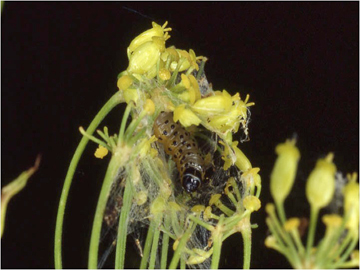 Parsnip webworm. Photo courtesy of Berenbaum. |
Mary Berenbaum: Microevolutionary changes (changes in gene frequencies within populations) can take place very rapidly—across one or two generations. For example, the parsnip webworm appeared in New Zealand for the first time in 2004, attacking wild parsnip plants that have been growing there without any major insect enemies for 150 years. We’ve been measuring the chemical defenses of wild parsnip plants in New Zealand from 2007 to 2010 and have recorded changes in the chemical composition of populations attacked by webworms even in this very short period of time.
Mongabay: What impact does this ‘arms race’ have on present day agricultural?
Mary Berenbaum: The most important lesson is that insects and weeds are highly adaptable and evolve rapidly—no interaction is static and we can expect pests to evolve coping mechanisms in response to almost anything we attempt to use to control them (including genetically modified plant strains, novel synthetic organic pesticides, cultural methods such as crop rotation, and even natural enemies used in biocontrol).
CONSERVATION
Mongabay: Why do insects matter?
Mary Berenbaum: People tend to equate small size with unimportance but that’s simply not a biologically realistic point of view. The importance of insects to maintaining most ecosystems is wildly disproportionate to their size—insects are among the world’s most irreplaceable pollinators, nutrient recyclers, and waste haulers. They play an important role in many food webs—every class of vertebrates includes species that depend on insect food for survival. In many communities, insects are keystone species—a species that is critical to the survival of every other organisms in a community. Just as a keystone maintains the integrity of a stone arch, a keystone species maintains the integrity of an entire community; the removal of a keystone in either case can result in a collapse of the entire structure. Fig trees, for example, are considered keystone species in tropical communities around the world, providing food for toucans, hornbills, parrots, and pigeons, as well as bats, rodents, and monkeys, insects and other invertebrates, and even fish in nearby river. Every species of fig tree, however, depends on only one or two species of tiny wasps for pollination. Without these specific insects, there can be no fig fruits or future fig trees. A cascade of ecological consequences may result from the loss of an insect smaller than a grass seed.
Mongabay: How can society as a whole do better care for the insects of the world?
Mary Berenbaum: The best thing people can do is to stop assuming that insects don’t belong on this planet and that it’s our job to destroy them. Insects have lived on Earth far longer than humans have, in many more different places, and they’ve found at least a million different ways to make a living here—we’re living on their planet, not the other way around. My hope is not that everyone will become an entomologist but that more people will appreciate insects for their amazing diversity and adaptability.
Mongabay: Why is it important to make sure the public is not left in the dark when it comes to scientific findings?
Mary Berenbaum: Having the best information available helps people to make the best decisions and so many decisions in everyday life depend on at least some level of science knowledge. Even an activity as ordinary as shopping in a grocery store involves making decisions that can be informed by scientific evidence. In the United States, the majority of voters really determines environmental, economic, and other policy decisions so we all benefit from having a scientifically literature electorate. Beyond personal and political decision-making, scientific knowledge helps people to understand and appreciate the world and all of its complexities; it’s the best insurance against irrational fear.
Related articles
U.S. bumble bees experiencing significant declines
(01/04/2011) Many US bumble bee populations have declined significantly over the past few decades, with certain species dropping off by as much as 96%. While the decline is linked to low genetic diversity and disease, an underlying cause remains uncertain.
Uncovering the intelligence of insects, an interview with Lars Chittka

Loss in biodiversity may be killing bees
(01/20/2010) A decline in diverse plants species on which to feed may be causing a similar decline in bee survival, according to a new paper in Biology Letters.
Forgotten species: discovering the shimmer of Maathai’s Longleg
 (01/13/2010) Few species receive less respect and less conservation attention than insects. This despite the fact that they are some of the most diverse species on the planet andthey provide a number of essential services to humankind, including pollination, pest control, production (for example honey and silk), waster recycling, and indications of habitat health. Scientists are not only unsure just how many species of insects are threatened in world; they are equally uncertain how many insects exist. Currently there are nearly a million insect species described by science, but millions more likely exist. It’s probable that innumerable insect species have vanished before even being catalogued by entomologists.
(01/13/2010) Few species receive less respect and less conservation attention than insects. This despite the fact that they are some of the most diverse species on the planet andthey provide a number of essential services to humankind, including pollination, pest control, production (for example honey and silk), waster recycling, and indications of habitat health. Scientists are not only unsure just how many species of insects are threatened in world; they are equally uncertain how many insects exist. Currently there are nearly a million insect species described by science, but millions more likely exist. It’s probable that innumerable insect species have vanished before even being catalogued by entomologists.
World of Avatar: in real life
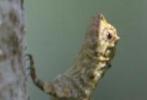 (01/13/2010) A number of media outlets are reporting a new type of depression: you could call it the Avatar blues. Some people seeing the new blockbuster film report becoming depressed afterwards because the world of Avatar, sporting six-legged creatures, flying lizards, and glowing organisms, is not real. Yet, to director James Cameron’s credit, the alien world of Pandora is based on our own biological paradise—Earth. The wonders of Avatar are all around us, you just have to know where to look.
(01/13/2010) A number of media outlets are reporting a new type of depression: you could call it the Avatar blues. Some people seeing the new blockbuster film report becoming depressed afterwards because the world of Avatar, sporting six-legged creatures, flying lizards, and glowing organisms, is not real. Yet, to director James Cameron’s credit, the alien world of Pandora is based on our own biological paradise—Earth. The wonders of Avatar are all around us, you just have to know where to look.
First comprehensive study of insect endangerment: ten percent of dragonflies threatened
 (06/23/2009) A lot of time, effort, and funds have been spent on programs evaluating the threat of extinction to species around the world. Yet insects have not benefited from these programs, which have largely focused on more ‘charismatic’ species such as mammals, birds, amphibians, and reptiles. This gap is clearly shown by the fact that 42 percent of vertebrates have been assessed by the International Union for the Conservation of Nature (IUCN), and only 0.3 percent of invertebrates.
(06/23/2009) A lot of time, effort, and funds have been spent on programs evaluating the threat of extinction to species around the world. Yet insects have not benefited from these programs, which have largely focused on more ‘charismatic’ species such as mammals, birds, amphibians, and reptiles. This gap is clearly shown by the fact that 42 percent of vertebrates have been assessed by the International Union for the Conservation of Nature (IUCN), and only 0.3 percent of invertebrates.
The honeybee can count
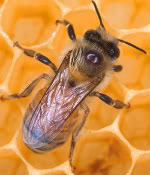
(01/29/2009) Plato once said: “numbers are the highest degree of knowledge: it is knowledge itself.” By Plato’s standards researchers have just discovered that the honey bee is a knowledgeable insect indeed. The honey bee can count to three in an instant according to a new study in the online journal PLoS ONE. Using dots and other abstract symbols, scientists from the Vision Centre in Australia tested whether the honey bees had the ability to count items in their environment.
Pollination worth $216 billion/yr for food production
(09/16/2008) Pollination services provided by insects are worth $216 billion (€153 billion) a year reports a new study published in Ecological Economics. The figure represents about 9.5 percent of the total value of world agricultural food production.
Colorful insects help search for anti-cancer drugs
(07/07/2008) Brightly-colored beetles or caterpillars feeding on a tropical plant may signal the presence of chemical compounds active against cancer and parasitic diseases, report researchers writing in the journal Frontiers in Ecology and the Environment. The discovery could help speed drug discovery.
Billions of disappearing bees linked to virus
(09/06/2007) Scientists have linked the disappearance of tens of billions of bees to a virus, reports a study published in the 7 September issue of the journal Science. Colony collapse disorder (CCD), in which colonies inexplicably lose all of their worker bees, has been blamed for the loss of 50-90 percent of colonies in beekeeping operations across the U.S.
Mysterious outbreak killing millions of bees
(02/14/2007) An mysterious outbreak is causing the deaths of millions of honeybees in 22 states according to an entomologist from the University of Montana. Jerry Bromenshenk says that Colony Collapse Disorder (CCD) is “causing agricultural honeybees nationwide to abandon their hives and disappear.”